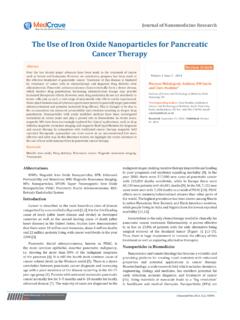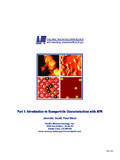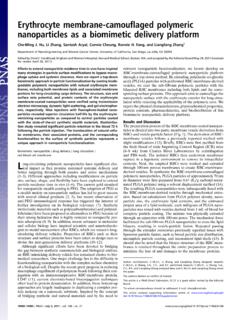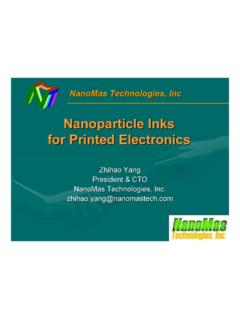Transcription of Effectively Grinding And Dispersing Nanoparticles …
1 Effectively Grinding And Dispersing Nanoparticles Using A Fine Bead Mill By: Dr. Stefan Mende - Research and Development; Mr. Gerhard Kolb - Vice President, Sales; Mr. Udo Enderle - Manager, Engineering Department at NETZSCH-Feinmahltechnik GmbH New and Not-So-New Nanoparticles The special properties often exhibited by Nanoparticles have made possible advancements such as extremely hard and scratch-proof coatings, low sintering temperature ceramics, materials with a high fracture strength and toughness at low temperatures, and amorphous metals, to name but a few.
2 Of course, materials like carbon black and ultrafine titanium dioxide, which are essentially Nanoparticles , have been available for some time emerging before the widespread popularity of Nanoparticles as both a concept and a term. Indeed, when one considers that particle sizes classified as nanoparticle range from 10 - 700 nanometers, it s clear that most components processed on a bead mill fall into the area of nanotechnology. Most pigments used in inks and coatings, for instance, have a primary particle size from 20 to 200 nanometers, meaning that many operators of bead mills are already Grinding and Dispersing in the nano range.
3 However, there exist real difficulties in the effective design, development and delivery of Nanoparticles , most particularly in the area of dispersion. Just as the benefits of Nanoparticles are being more and more widely appreciated, issues in their manufacture and dispersion have also emerged. Key among these is the problem or particle agglomeration, or the tendency of the particles to adhere in small clumps, making dispersion and effective use of the Nanoparticles much more difficult and costly. Agglomerated due to the nature of the manufacturing process or storage the ultimate goal of manufacturers and users is to disperse all Nanoparticles to their primary particle size.
4 To this end, Netzsch Fine Particle Technologies has developed a variety of advances in fine bead mill equipment to carry out the tasks associated with Grinding at the nano level especially with regard to the dispersion function. Using Fine Bead Mills to Disperse Nanoparticles Nanoparticles must be first dispersed in a liquid to be used Effectively , and over the past few years, the use of fine bead mills for Grinding and dispersion of these particles has become more and more prevalent. Fine bead mills, widely used in both laboratory and production applications, deliver an efficient method for the Grinding and dispersion of nanoscale particles from 20 to 200 nanometers.
5 Popular because of their simplicity and scalability, fine bead mills also offer lower costs when compared with alternative technologies such as plasma gas process techniques. Often used in conjunction with these plasma gas process techniques, fine bead mills provide an especially efficient way to disperse the output to primary particle size - usually in just one or two passes. So what are the operating conditions required for a bead mill to grind and disperse Nanoparticles Effectively and efficiently? Achieving Repeatable Nanoparticle Dispersions Researchers, manufacturers, and others need to be able to achieve reliable, repeatable distributions of submicron particles.
6 The traditional plasma gas process promises superior particle uniformity, but does not offer the ability to disperse particles in a solution at their primary size. A fine bead mill with Grinding media on the order of 100 microns ( m) to 200 m is the simplest, most scalable, most cost-efficient way to make and disperse Nanoparticles , though this too presents obstacles. For example, research shows that when running passes through a media mill, a portion of the batch bypasses the Grinding process, short-circuiting through the chamber. This phenomenon is inherent in all fine media mills regardless of design.
7 The ideal mill, therefore, would have plug flow, where all the material passes through the machine at the same velocity, producing a uniform grind and residence time distribution. To achieve near plug flow, high throughput rates that result in a uniform velocity of particles through the mill, are required. Bear in mind though, that at high flow rates horizontal or vertical bead mills are very sensitive to hydraulic packing of media. A design is required that will increase the kinetic energy of the beads and thus reduce hydraulic packing associated with high velocity flow.
8 The open surface area of the discharge must be increased to allow the high flow rate to occur without high chamber pressure while at the same time accommodating for the risk of damaging Nanoparticles through the use of excessive energy and rotational forces. New Media Mill Design for Dispersing Nanoparticles Dispersing Nanoparticles into liquids can be a challenging undertaking. The tremendous surface area and surface energy which delivers the beneficial effects of nanomaterials also prevents their easy dispersion into liquids. On top of that, conventional technologies for Dispersing powders into liquids are not sufficient for Dispersing these tiny particles as discrete entities.
9 The production of stable suspensions or dispersions of nano particles actually requires a comminution process, such as a small-media mill provides. On an industrial level, this Grinding of coarser particles into the nanometer range or Dispersing agglomerated nano-sized primary particles is done with a bead mill, even though the high energy and bead speeds typically required can lead to material contamination or the destruction of the crystalline structure of the particle. It has been discovered that mills using very fine media beads, in the range of 70-125 m, can economically grind materials into the nanometer range.
10 It has also been discovered that unique mill designs using ultra fine Grinding beads 30-50 m in size offer an effective solution for Dispersing these particles with significantly improved process efficiency. The limitation in the process up to this point has been the lack of knowledge concerning scalable industrial equipment that use these small beads, or rather that this method is not widely accepted due to the difficulty in handling the small Grinding beads, removing the beads from the suspension after Dispersing the particles, or loading and discharging the small beads into the machine.






